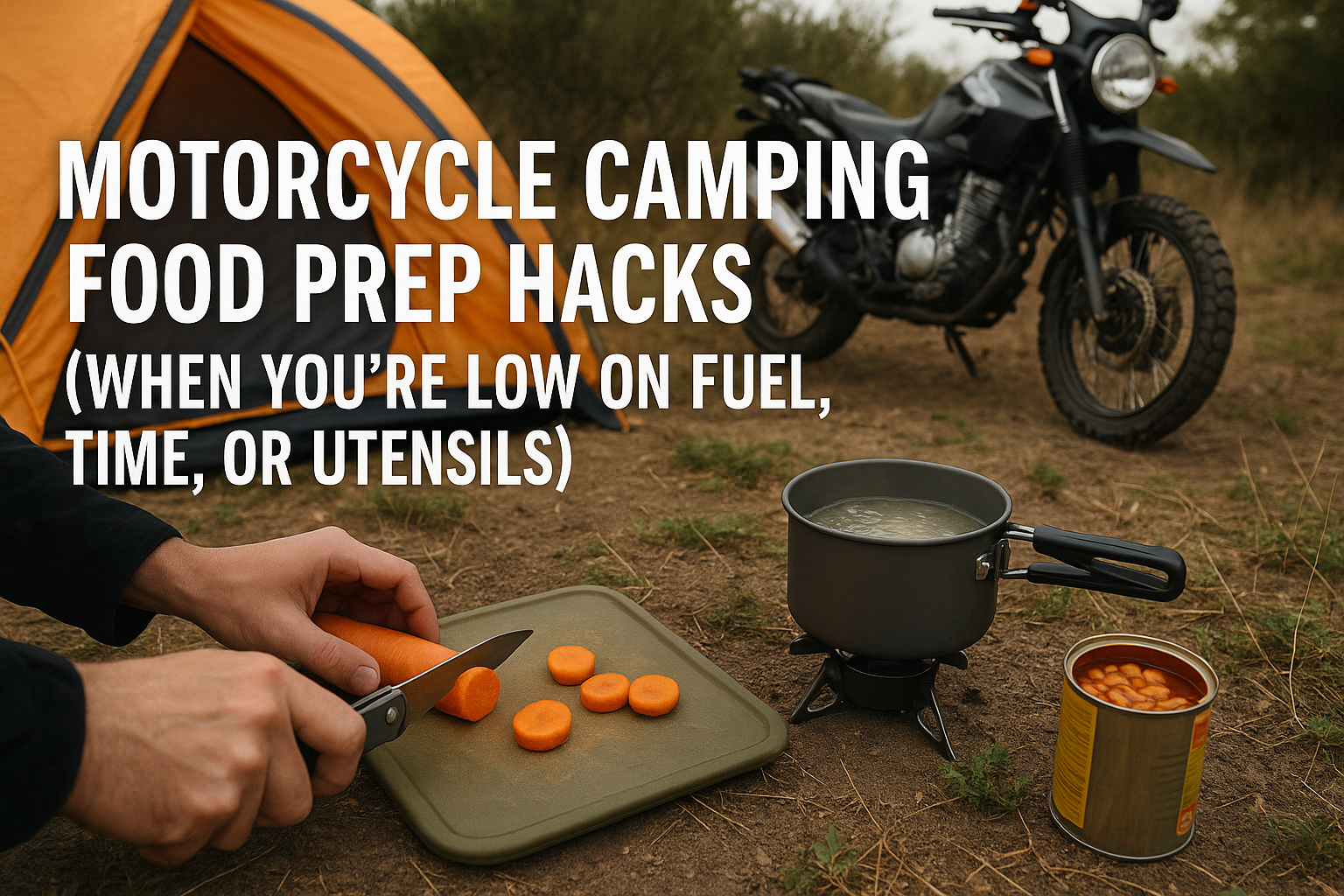When you’re out on the open road with nothing but your bike, your gear, and the sound of the wind, the last thing you want to worry about is how to make dinner when your fuel canister runs out, you forgot your fork, or daylight’s disappearing fast. Motorcycle camping comes with real constraints: limited space, minimal tools, and unpredictable weather.
So what do you do when you can’t light a fire, don’t want to unpack your whole setup, or just want a hot meal with zero mess? You get clever. This is the art of survival cooking without a stove—designed for minimalists, lone wolves, and road-bound warriors.
Tactical Pre-Prep: Before You Hit the Throttle
Most campers tell you to prep meals before the trip. Sure—but we’re not talking sandwiches and trail mix. We mean tactical, multi-use, vacuum-sealed layer meals that are shaped to slide into saddlebags like folders in a filing cabinet.
Each vacuum-sealed pack becomes a flat brick of nutrition: quinoa on the bottom, a scoop of lentils or tuna in the middle, a smear of tahini or coconut oil on top, and a dusting of spice. These bricks are waterproof, fuel-free, and stack better than any plastic container.
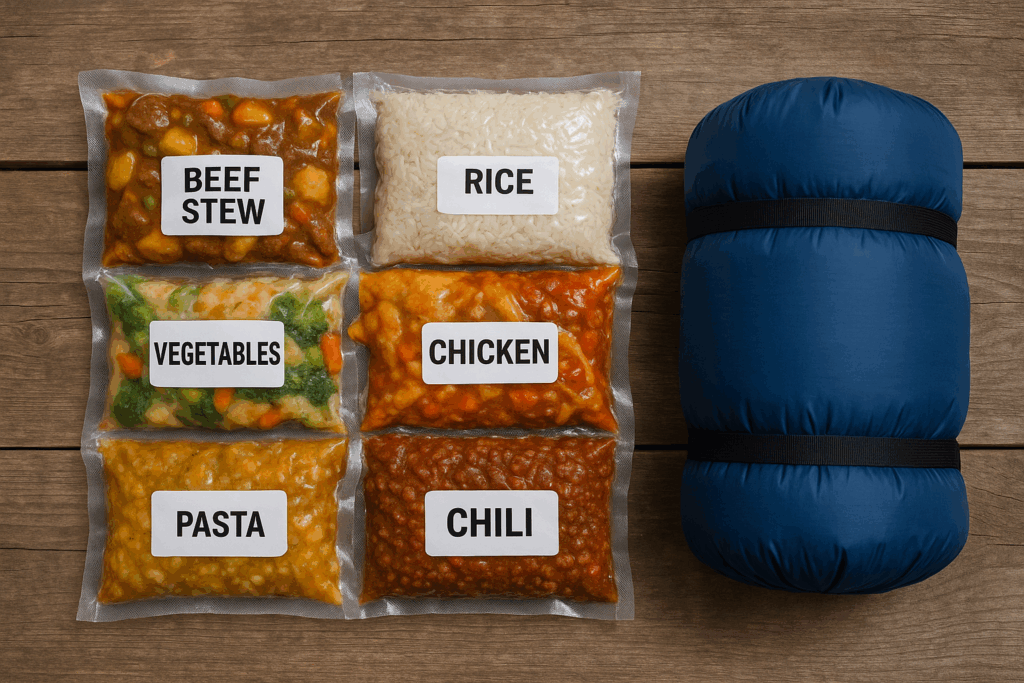
✱ Tip: Pre-freeze them before your ride if you’re heading into cold climates—they’ll stay cold longer and prevent spoilage.
You can also prep dry-mix bottles using wide-mouth Gatorade bottles. Think protein pancake mix, instant polenta, or oats with powdered milk and spices. Add water, shake, and you’ve got batter or porridge—no bowl required. The wide mouth lets you eat straight from the bottle.
Heatless Hydration: When Boiling Water Isn’t an Option
Ever tried cooking with no flame? You’d be surprised how far you can get just by soaking and warming with natural sources.
Start with cold-soak oats or couscous in zip-seal pouches. Before you set up camp or crawl into your sleeping bag, fill a pouch with your dry grains and just enough clean water. Then tuck the pouch inside your jacket or sleeping bag. Your body heat gently hydrates the food overnight.
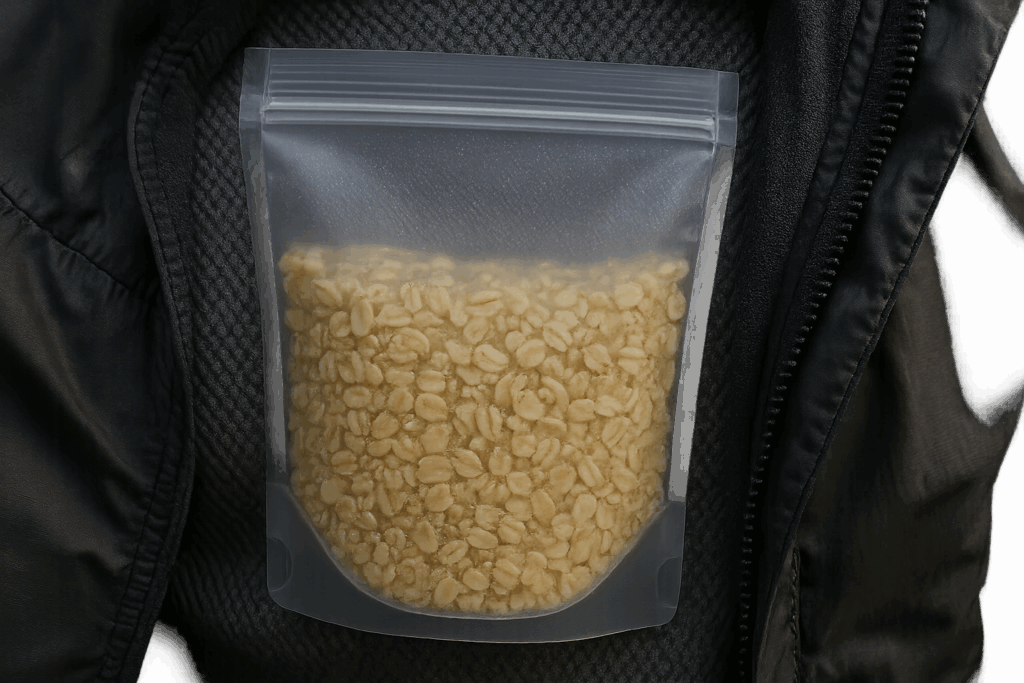
Even better—use pre-packed soup or curry pouches (like lentil dahl or bone broth). Tuck them under your jacket while riding, especially on long, warm rides. By the time you’re parked for camp, the food’s already warm. These pouches double as hand warmers and even insulation for fragile gear.
Pro tip: Wrap one of those soup pouches in a spare sock, then wedge it between your base layer and windbreaker on a long ride.
Dual-Purpose Meals: When Food Becomes Gear
When space is limited, everything should serve more than one purpose—including what you eat.
Take vacuum-packed tortillas: soft, durable, and immune to crushing. They act as edible plates, spoons, even gear padding between your helmet and your pot set.
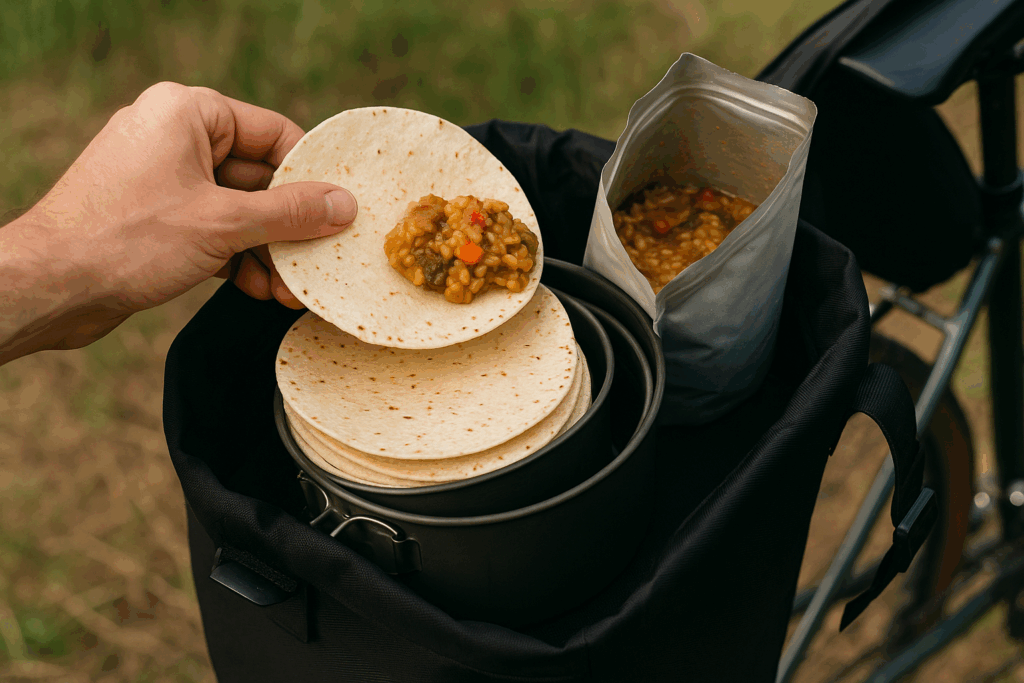
Then there’s hard cheese and salami logs—calorie-dense, long-lasting, and temperature-resistant. But here’s the kicker: they can be carved with your knife, which means you now have a sharp-tool-use excuse every mealtime.
When You Have No Utensils Left
It happens. You forget your spork or lose your pot lid to the wind. No panic—just improvise.
Pull out two tent pegs or kindling sticks, shave them smooth, and you’ve got chopsticks. They double as skewers, flame pokers, and even toggles for tent lines.
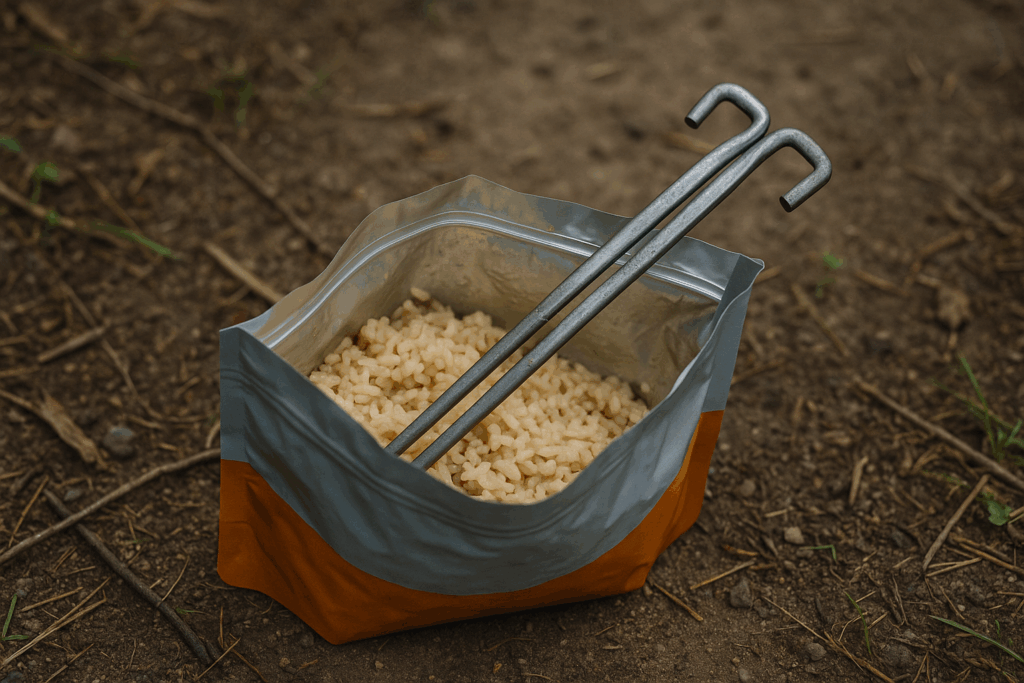
Also, if you’re eating from a food pouch, just cut it lengthwise and squeeze from the bottom. The wide opening becomes your bowl. This trick isn’t just for ultralight hikers anymore—it works for chili, oats, pasta, and even fruit mixes.
Heat Without Fuel: Secret Cooking Methods on the Road
Running low on fuel doesn’t mean going hungry.
First, look into MRE-style flameless heaters. These magical little pouches heat up when you add water—no fire, no fuel. Just place your vacuum meal pouch or soup pack inside and let it warm while you set up your tent.
Tip: Carry at least 2 flameless ration heaters per 3-day trip—they weigh little and can be used in emergencies.
Another underrated method? The solar thermos trick. Paint a thermos black or wrap it in black duct tape, fill it with water or soup, and set it in direct sun for 1–2 hours. In hot regions, it’ll warm to 130°F or more—enough to hydrate freeze-dried meals or soften pasta.
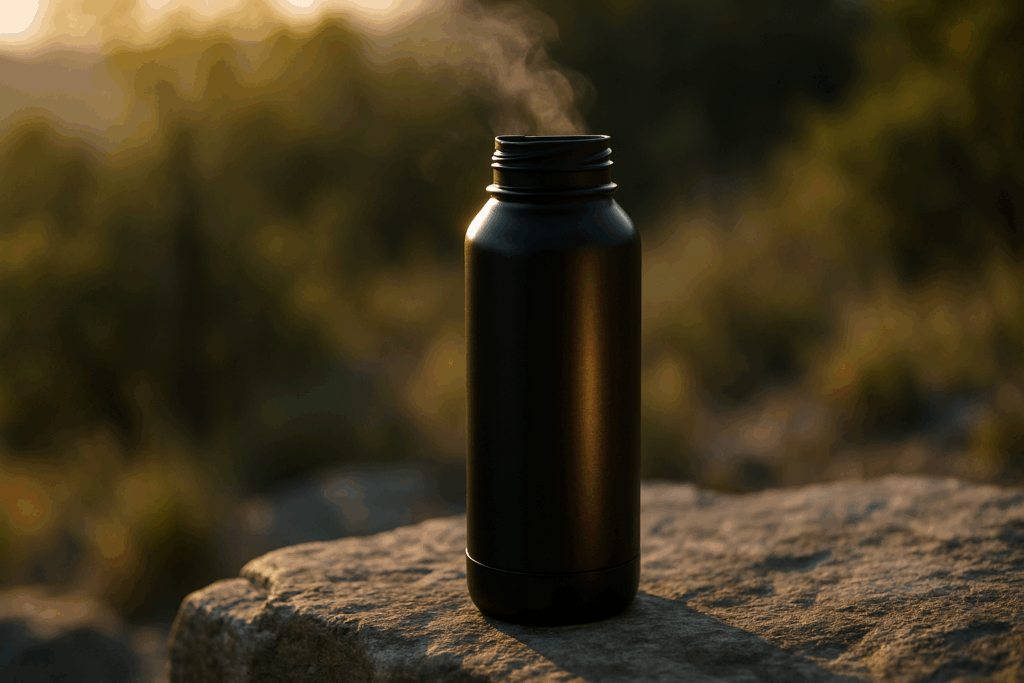
Snacks That Do More Than Feed
You already carry protein bars, but did you know some can act as fire starters in a pinch?
High-fat bars (especially with coconut oil) will ignite and stay lit, especially helpful when kindling is damp. Keep a couple of individually wrapped ones in your emergency pouch, not just for calories but for warmth.
And let’s not forget ghee packs. These little cubes of clarified butter don’t just add fat to meals—they can coat lips, soothe sunburns, and lube zippers. Carry a few in a contact lens case or sealed straw.
Smart Water Use for Meal Prep
Water is sacred when riding remote. Here’s how to prep food with almost zero waste.
Use a two-stage method: rinse your mouth, then use that same clean water (from a sipped bottle) to soak your next meal. If you rinse first, you avoid contamination. It’s a trick from desert hikers and long-haul overlanders.
If desperate for more water, hang a clean trash bag inside your rainfly overnight. Condensation will build and collect at the bottom. It’s not much—but it’s enough for soaking oats or brushing teeth.
Meal Multipliers: 1 Food, 3 Ways
This is the kind of efficiency every moto-camper dreams of.
Ramen Noodles
- Eat dry like chips on the road.
- Cold-soak half in a zip bag with seasoning.
- Crush the rest and sprinkle on top of warm meals as a crunchy topping.
Tea Bags
Pre-pack dry seasonings (cumin, garlic, curry, etc.) into reusable muslin tea bags. Throw one into your soak pouch or hydration bottle to flavor the meal or drink without needing extra bottles. One tea bag = flavor for two meals.
Final Thoughts: Ride Hungry, Eat Smart
This isn’t about gourmet meals—it’s about survival with style. It’s about warming your dinner under your jacket while crossing a mountain pass. It’s knowing your protein bar might spark your next fire. It’s understanding that you don’t need a stove to cook—you need ingenuity.
Every ounce saved is another mile earned. Every hack is a step toward independence. Motorcycle camping food prep is less about what you carry and more about how you think.
So next time you feel the cold setting in, the sky turning black, and your fuel can running dry—remember:
You are the stove. You are the prep station. You are the flame.
Keep riding, keep adapting. And keep your soup pouch close—it might just save your fingers and your soul.

